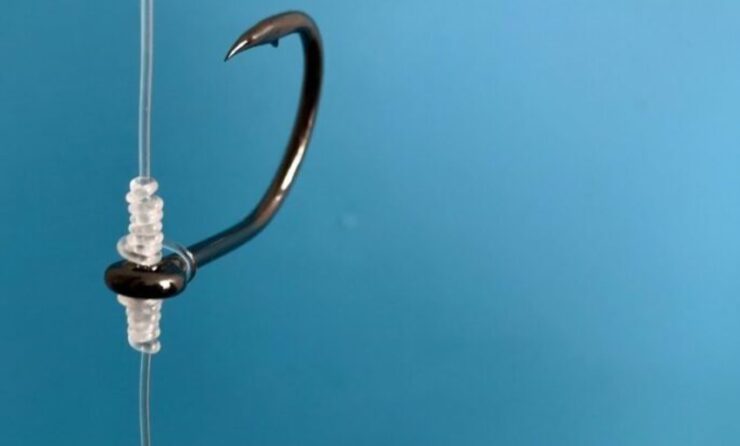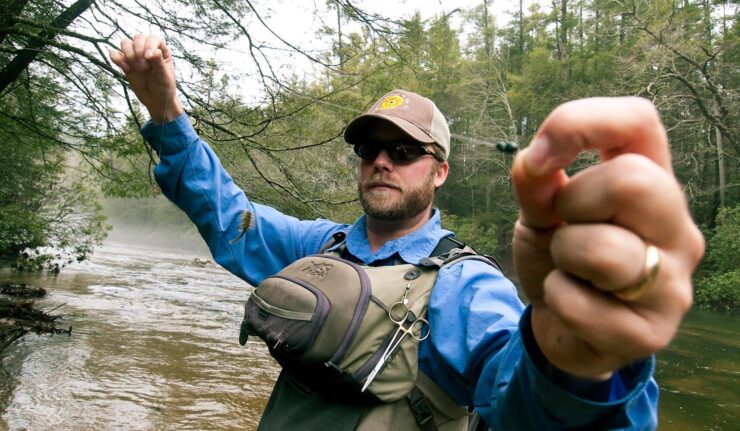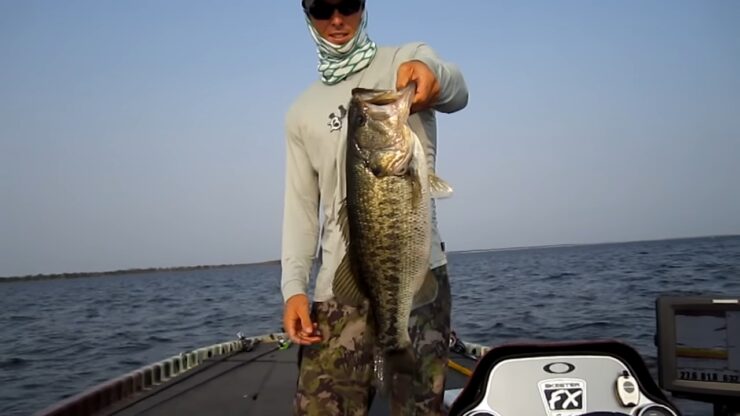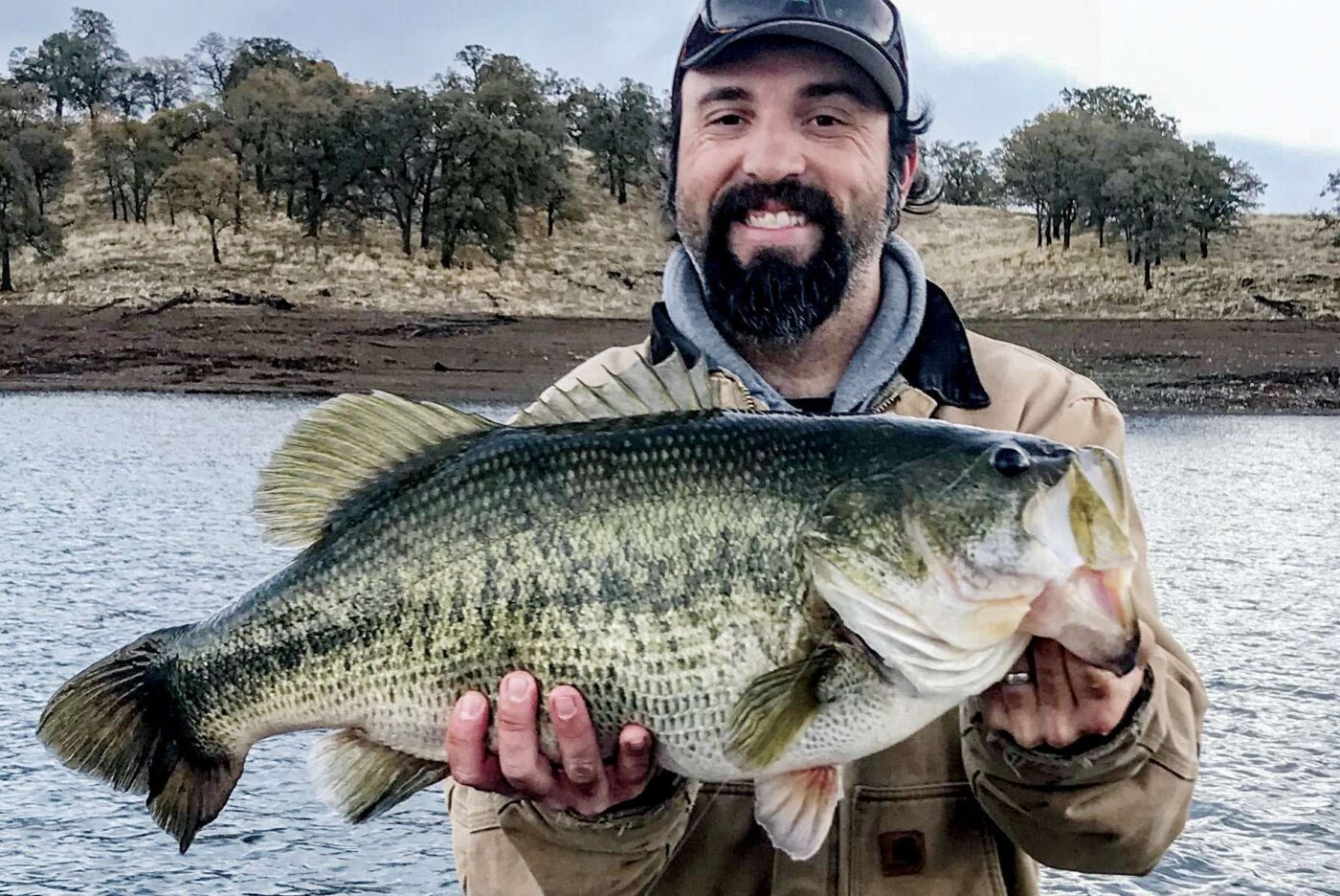Most hard-core bass anglers would agree that the majority of really big bass are caught in deep water.
While there are several techniques you can use to reach deep-water bass, one of my favorites is a ‘Drop-Shot’ rig. A Drop Shot rig is simply a plastic lure, like a worm, shad body, or live bait, fished on a #1 wide-gap hook tied directly to the running line approximately 18 to 24 inches above a 3/16th ounce weight.
The key to remember is that the worm is tied above the hook. This is a type of finesse fishing, meaning the bait can be fished much more precisely. It is similar to vertical fishing, but the depth and location can be maintained with exact precision, sort of like a surgical strike.
It can also be fished directly into the heaviest cover.
Table of Contents
ToggleHow To Set Up a Drop-Shot Rig
There are basically three ways to set this rig up:
- Texas Rigged – where the hook point is buried back into the worm to make it weedless. This is the preferred method for fishing structures such as deep timber and logs.
- Hooked directly through the tip of the nose, with the hook exposed – This allows more action from the body, and is great for fishing in current, such as in rivers, and below tail-races.
- Wacky-Style – where the hook is placed through the center of the worm and left exposed. This provides the most action.
The last two rigging methods are best used in deep, open water where bass are suspended away from the structure.
Your rod needs to be an ultra-sensitive, graphite, medium-action rod. I would recommend a bait-casting reel, but you can use a spinning reel if you prefer, spooled with a 6-8 pound test line. Some of the hits on this rig will be very, very light, so you need the sensitivity to detect them. Your regular heavy-action worm rod will not work for this technique.
Using The Drop Shot properly

To use the rig, simply drop the rig to the bottom in 30-50 feet of water, in a suitable location, and gently ‘twitch’ the bait up and down, just a few inches, periodically. It’s like jigging, only more subtle. One company has commercialized this rig, calling it the Banjo Minnow System. The weight on the bottom allows your depth to be maintained at an exact distance from the bottom.
A few tips for this rig are:
- As a rule, shad don’t suspend around cover. They are open-water fish and like to mill around and travel freely. So if using Sassy Shads, choose your locations accordingly.
- Use your electronics to help you find and stay on the baitfish if you are “matching the minnow”.
- The Drop Shot method is deadly on both active and not-so-active fish. This rig allows you to drop the worm right in front of its face. Few fish will refuse such an easy meal.
- Don’t overpower your finesse baits with rods and lines that are too heavy for this Think small.
- Watch the birds for feeding action. Keep a casting rod handy, rigged with a surface lure, or a crankbait when the bass hit on the surface. Fish are opportunistic, so there’s no reason for you not to be. Think “adapt, adjust, and persevere…“
- Don’t get discouraged if your expectations are not met the first few times you try out this rig. Like anything else worthwhile, there is a learning curve to this technique. The more you use it, the better you get at it. Soon, you’ll wonder how you got along without it.
It’s All About Structure

Deep-water bass fishing, more than any other situation, will require you to use structure. There is a big difference between ‘structure’ and ‘cover’. ‘Cover’ is a distinct physical object that is not part of the bottom contour.
Bass use them, but only temporarily. ‘Structure’ is the actual features that make up the bottom contour, such as edges, holes, channels, old riverbeds, shoals, etc… All fish use these as highways or trails in their travels. They will use the same ‘trails’ all the time unless something happens to change them. It’s a lot like hunting, where you need to learn where the regularly traveled trails are.
Once you learn these, you can catch just about any kind of fish, all year long.
To be successful, your preparations begin long before you ever hit the water. You need to do some homework. Get a contour map of your lake, and study it intensely. You can mark likely areas with color-coded highlighters. Here is what you should look for.
The big secret to any fishing is to keep it simple. We can base the entire life cycle of bass on knowing just two things: Their spawning areas (flats), and their wintering areas (deep-water vertical-break areas). The structure breaks that connect these two areas are their migration trails. All you need to do is figure out where along the trail they are at the time you are fishing.

Bass will winter in the deepest water/vertical break areas available. In the early spring (pre-spawn), the bass begins their movements up toward spawning flats and creeks. They use main creek channels or the main lake drop as their route.
They stop off at points and humps first, then secondary points, on their way to the spawning grounds. When spawning is complete, they head back out the same way, stopping at secondary points, then main points, and humps.
Summer bass tends to scatter throughout the system, but most will be along with the main deep-water channel areas. In the fall they will again move shallow, using the same points and humps they did before, to gorge up for winter. Where you find large schools of baitfish along these routes, you will find bass.
The rest is just trial-and-error, checking each likely place out. When you find bass, mark it on the chart. They will be there at this time next year.
Many anglers believe that bass like to hang out in deeper water with easy access to the shallows, so they can cruise into them at night to feed. This is only true for smaller bass, most of which are males. The really big fish, which are always female, seldom leave deep water, except to spawn.
There are some general guidelines for deep-water structures. During periods of active feedings, such as low light, rain, and wind, the fish generally move shallower and hold less tight to cover. During periods of high pressure, or under adverse conditions, the bass tends to be a little deeper, and closer to cover.
Structure with a hardcover on it is better in the spring and late fall (shell/rock). Structure with softcover and current is better in the summer. Structure areas with more vertical breaks, such as ledges, are better during the winter. A thin echo bottom line on your LCD represents a hard bottom. A thick echo represents a softer type bottom. Turning the gain all the way up on your LCD will enable you to find hard bottom/soft bottom areas, and help you locate the thermocline.
Next time you are out bass fishing, give the Drop Shot a try. I am confident you will be glad you did.
Happy fishing
Meet Maria Alexander, the fearless adventurer steering the ship at KayakPaddling.net. Her mission? To convince you that life’s too short for dry land and that the best stories always start with “So there I was in my kayak…”
Related Posts:
- 12 Best Fishing Lures Ever 2024 - Baits That…
- 12 Best Water Socks in 2024 - Swim and Dive Tested
- The Complete History of Plastic Worms for Fishing…
- 16 Best Kayak For Beginners 2024 - Kayaking Adventure Gear
- Where Is The Water Intake on A Mercury Outboard? -…
- 17 Best Trolling Reels 2024 - Enjoy your Fishing Adventure












